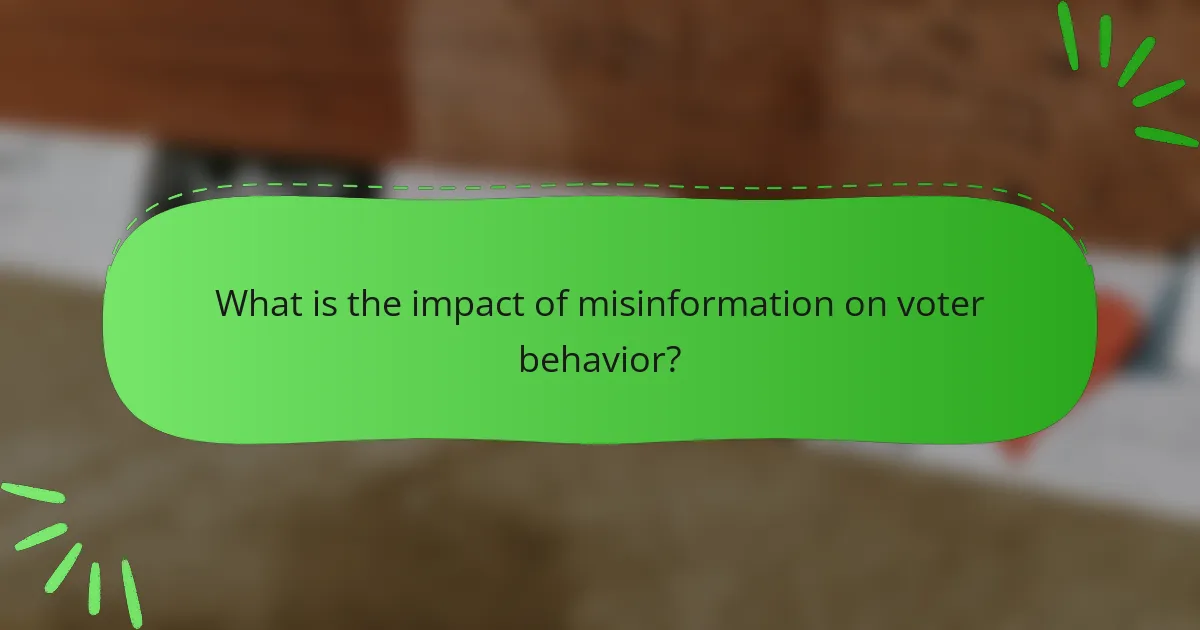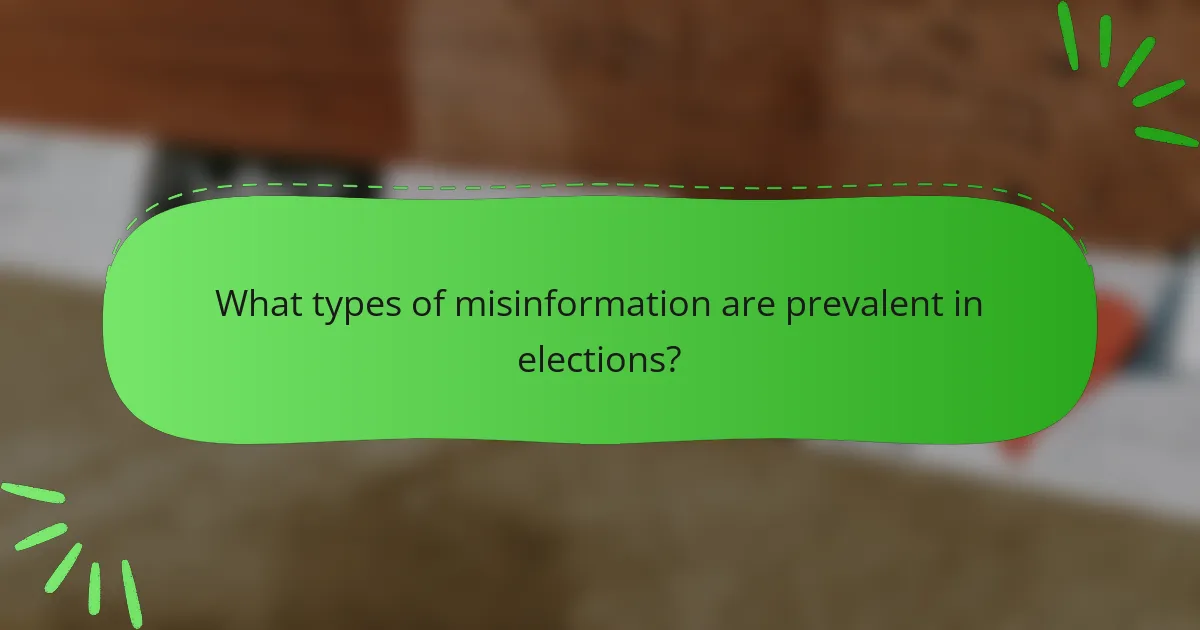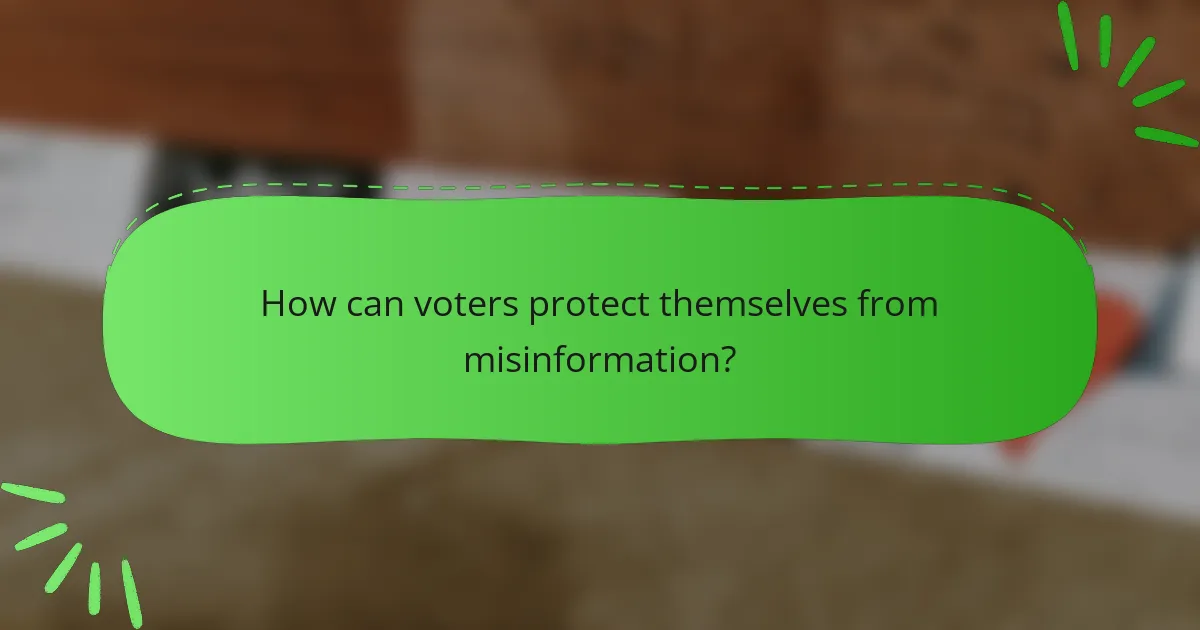Misinformation significantly impacts voter behavior, leading to confusion about candidates and policies, which can result in misinformed decisions and decreased voter turnout. Research shows that 64% of Americans believe misinformation influences their voting choices, contributing to increased polarization and extreme voting patterns. Common types of misinformation include false claims about candidates, misleading statistics, and fabricated news stories, often amplified by social media during election cycles. Voters can combat misinformation by verifying information, checking sources for credibility, and enhancing their media literacy to better discern facts from falsehoods.

What is the impact of misinformation on voter behavior?
Misinformation significantly alters voter behavior. It can lead to confusion about candidates and policies. This confusion often results in misinformed decisions. Research indicates that exposure to false information can decrease voter turnout. A study by the Pew Research Center found that 64% of Americans believe misinformation affects their voting choices. Additionally, misinformation can polarize opinions, increasing partisan divides. This polarization can lead to more extreme voting patterns. Ultimately, misinformation undermines the democratic process by distorting informed decision-making.
How does misinformation influence voter decision-making?
Misinformation significantly influences voter decision-making by shaping perceptions and beliefs. It can lead voters to make choices based on false or misleading information. For example, studies show that misinformation can alter opinions about candidates and policies. A 2017 study published in the journal “Political Communication” found that exposure to false information decreased the likelihood of voting for certain candidates. Additionally, misinformation can create confusion about voting procedures, impacting turnout. Research indicates that voters who encounter misinformation may rely on it over factual information. This reliance can distort the democratic process by undermining informed decision-making.
What psychological mechanisms are affected by misinformation?
Misinformation affects several psychological mechanisms, including belief formation, memory recall, and decision-making. Belief formation is influenced as individuals may adopt false beliefs based on misleading information. Memory recall can be distorted, leading to false memories or altered perceptions of past events. Decision-making processes are impacted, as individuals may make choices based on inaccurate information, leading to poor judgment. Research has shown that misinformation can create cognitive biases, such as confirmation bias, where individuals favor information that confirms their preexisting beliefs. This can result in a polarized view of issues, particularly in the context of voter behavior. A study by Lewandowsky et al. (2012) highlights how misinformation can undermine public understanding and influence opinions, demonstrating its significant impact on psychological mechanisms.
How does misinformation alter perceptions of candidates and issues?
Misinformation significantly alters perceptions of candidates and issues by creating false narratives. These narratives can lead to misunderstandings about a candidate’s qualifications or policy positions. Research indicates that misinformation can decrease trust in political institutions. For example, a study by the Pew Research Center found that 64% of Americans believe misinformation impacts their understanding of political issues. This distortion can result in voters making decisions based on inaccurate information. Consequently, candidates may be unfairly judged, affecting their electoral success. Misinformation also polarizes public opinion, making dialogue more contentious.
Why is understanding misinformation crucial for electoral integrity?
Understanding misinformation is crucial for electoral integrity because it directly impacts voter perception and decision-making. Misinformation can distort facts about candidates, policies, and the electoral process. This distortion can lead to misinformed voting choices, ultimately undermining the democratic process. Studies show that misinformation can spread rapidly through social media, influencing large numbers of voters. For instance, a 2020 study by the Pew Research Center found that 70% of Americans had encountered false or misleading information about the election. This prevalence highlights the necessity of understanding misinformation to safeguard electoral integrity. Addressing misinformation effectively can help ensure that voters make informed decisions based on accurate information.
What are the potential consequences of misinformation on election outcomes?
Misinformation can significantly alter election outcomes. It can lead to voter confusion and misinformed decisions. For example, false information about candidates’ policies can sway public opinion. Misinformation can also suppress voter turnout by creating distrust in the electoral process. A 2020 study by the Pew Research Center found that 70% of Americans believe misinformation affects their voting decisions. Moreover, misinformation can create polarization among voters, reinforcing existing biases. This polarization can result in increased hostility and division within communities. Overall, misinformation undermines the integrity of democratic processes.
How can misinformation lead to voter apathy or disengagement?
Misinformation can lead to voter apathy or disengagement by creating confusion about the electoral process. When voters encounter false information, they may feel overwhelmed and unsure about whom to trust. This uncertainty can diminish their motivation to participate in elections. Additionally, misinformation can distort perceptions of candidates and issues, leading to disillusionment. Research indicates that 70% of Americans believe misinformation negatively impacts democracy, contributing to a sense of helplessness. Consequently, voters may choose to abstain from voting altogether.

What types of misinformation are prevalent in elections?
Types of misinformation prevalent in elections include false information about candidates, misleading statistics, and fabricated news stories. False information about candidates can involve unfounded claims regarding their character or policies. Misleading statistics often present data out of context to create a false narrative. Fabricated news stories are entirely made-up articles that mislead voters. Additionally, misinformation can take the form of altered images or videos that misrepresent events. Social media platforms frequently amplify these types of misinformation during election cycles. Research indicates that misinformation can significantly influence voter perceptions and behavior. According to a study by the Pew Research Center, 64% of Americans believe that made-up news has caused confusion about the basic facts of current events.
How do different forms of misinformation manifest during campaigns?
Different forms of misinformation manifest during campaigns through various channels and methods. Social media platforms often serve as primary vehicles for spreading false information. For instance, fabricated news articles can circulate widely, misleading voters about candidates’ positions. Misinformation may also appear in the form of manipulated images or videos that distort reality. Additionally, rumors and hearsay can proliferate within communities, creating confusion among voters. Research indicates that approximately 70% of Americans encounter misinformation during election cycles. This widespread exposure can significantly influence voter perceptions and decisions.
What role do social media platforms play in spreading misinformation?
Social media platforms play a significant role in spreading misinformation. They enable rapid dissemination of false information to a wide audience. Algorithms prioritize engaging content, often amplifying misleading posts. A study by the Massachusetts Institute of Technology found that false news spreads six times faster than true news on Twitter. Users frequently share information without verifying its accuracy. This behavior contributes to the viral nature of misinformation. Additionally, echo chambers on social media reinforce existing beliefs, making users more susceptible to false narratives. Overall, social media’s structure and user behavior facilitate the spread of misinformation, impacting voter behavior significantly.
How does misinformation differ across various voter demographics?
Misinformation varies significantly across different voter demographics. Younger voters often encounter misinformation through social media platforms. In contrast, older voters may receive misinformation via traditional media outlets. Studies show that education levels influence susceptibility to misinformation. Higher education correlates with a reduced likelihood of believing false information. Additionally, political affiliation shapes how individuals interpret misinformation. For example, partisan voters may accept misinformation that aligns with their beliefs. Research indicates that minority groups may face unique misinformation challenges. They often deal with targeted misinformation that exploits cultural stereotypes. Overall, the impact of misinformation is not uniform and is influenced by demographic factors.
What strategies can combat misinformation in electoral contexts?
Educating voters is a primary strategy to combat misinformation in electoral contexts. Providing accurate information helps individuals discern fact from fiction. Media literacy programs can enhance critical thinking skills. Fact-checking organizations play a crucial role in verifying claims. Social media platforms can implement stricter content moderation policies. Transparency in political advertising is essential for accountability. Collaboration between governments and tech companies can improve information dissemination. Studies show that informed voters are less susceptible to false narratives.
How can fact-checking organizations help mitigate misinformation effects?
Fact-checking organizations help mitigate misinformation effects by verifying claims and providing accurate information. They investigate the validity of statements made in public discourse. This process reduces the spread of false information. According to a study published in the journal “Science,” fact-checking can significantly decrease the belief in false claims. The study found that exposure to fact-checks reduced misinformation by 20%. Furthermore, fact-checking organizations promote media literacy. They educate the public on how to identify credible sources. This empowers individuals to critically evaluate information. Overall, fact-checking organizations play a crucial role in fostering informed voter behavior.
What role does media literacy play in reducing susceptibility to misinformation?
Media literacy significantly reduces susceptibility to misinformation. It equips individuals with critical thinking skills. These skills enable them to analyze and evaluate information sources. Media literacy helps distinguish credible content from misleading narratives. Research indicates that individuals with higher media literacy are less likely to believe false information. A study by the Stanford History Education Group found that many students struggled to evaluate online sources. This highlights the need for improved media literacy education. Enhanced media literacy fosters informed decision-making, especially during elections. Thus, it plays a crucial role in mitigating the impact of misinformation on voter behavior.

How can voters protect themselves from misinformation?
Voters can protect themselves from misinformation by verifying information before sharing it. They should check sources for credibility. Reliable sources include established news organizations and fact-checking websites. Voters can also cross-reference information with multiple outlets. Engaging in discussions with knowledgeable individuals can provide clarity. Additionally, voters should be cautious of sensational headlines. Awareness of common misinformation tactics helps in identification. Educating themselves about media literacy enhances their ability to discern facts.
What steps can individuals take to verify information before voting?
Individuals can verify information before voting by cross-referencing multiple reputable sources. They should consult official election websites for accurate details on candidates and measures. Fact-checking organizations provide unbiased evaluations of claims made during campaigns. Engaging with non-partisan voter education groups can also offer reliable insights. Checking the credibility of the source is crucial; established news outlets are generally more trustworthy. Additionally, individuals should be cautious of social media; misinformation spreads rapidly on these platforms. Researching the background and track record of candidates helps ensure informed choices. Lastly, discussing findings with knowledgeable peers can clarify any uncertainties.
How can voters identify credible sources of information?
Voters can identify credible sources of information by evaluating the source’s reputation and expertise. Credible sources typically have a history of accuracy and reliability. Voters should check if the information is supported by evidence, such as data or citations from reputable organizations. Peer-reviewed articles and official government publications are often trustworthy. Additionally, voters should be wary of sources that exhibit bias or lack transparency. Fact-checking websites can help verify claims made by media outlets or individuals. According to the Pew Research Center, 64% of Americans believe it is essential to evaluate the credibility of news sources. This highlights the importance of critical thinking in consuming information.
What tools are available for fact-checking claims made during campaigns?
Fact-checking tools available for claims made during campaigns include Snopes, FactCheck.org, and PolitiFact. Snopes provides a comprehensive database of fact-checked claims across various topics. FactCheck.org focuses on political claims and provides detailed analyses. PolitiFact rates the truthfulness of statements made by politicians on a scale from “True” to “Pants on Fire.” These tools utilize rigorous research methods and expert analysis to verify information. They help combat misinformation and promote informed voter behavior.
What best practices should voters follow to stay informed?
Voters should follow several best practices to stay informed. First, they should seek information from reputable sources. Trusted news outlets and official government websites provide accurate data. Voters should verify facts before sharing information. Misinformation can spread quickly, especially on social media. Engaging in discussions with knowledgeable individuals can enhance understanding. Attending community forums and town hall meetings offers direct insights. Additionally, voters should review multiple perspectives on issues. This approach helps in forming well-rounded opinions.
How can voters create a balanced media consumption strategy?
Voters can create a balanced media consumption strategy by diversifying their information sources. This involves consuming news from multiple outlets with varying perspectives. Engaging with both mainstream and independent media enhances understanding. Voters should also include international news to gain broader context. Fact-checking information through reputable organizations is essential. Studies show that exposure to diverse viewpoints reduces confirmation bias. According to the Pew Research Center, 64% of Americans believe it is important to get news from different sources. This approach helps voters make informed decisions while mitigating the impact of misinformation.
What resources are available to help voters navigate misinformation?
Resources available to help voters navigate misinformation include fact-checking websites, educational campaigns, and social media literacy programs. Fact-checking organizations like Snopes and FactCheck.org provide verified information on claims circulating online. Educational campaigns from organizations such as the National Association of Secretaries of State promote awareness about misinformation. Social media platforms also implement tools to flag or label misleading content. These resources aim to empower voters with accurate information and critical thinking skills. Studies show that informed voters are less likely to be swayed by false information.
The main entity of this article is misinformation and its effects on voter behavior. The article explores how misinformation alters voter decision-making, influences perceptions of candidates and issues, and impacts electoral integrity. It discusses the psychological mechanisms affected by misinformation, the types prevalent in elections, and the role of social media in spreading false narratives. Furthermore, it highlights strategies to combat misinformation, including media literacy and fact-checking, while providing resources for voters to navigate misinformation effectively. Overall, the article underscores the significance of understanding misinformation to ensure informed voting and maintain the integrity of democratic processes.